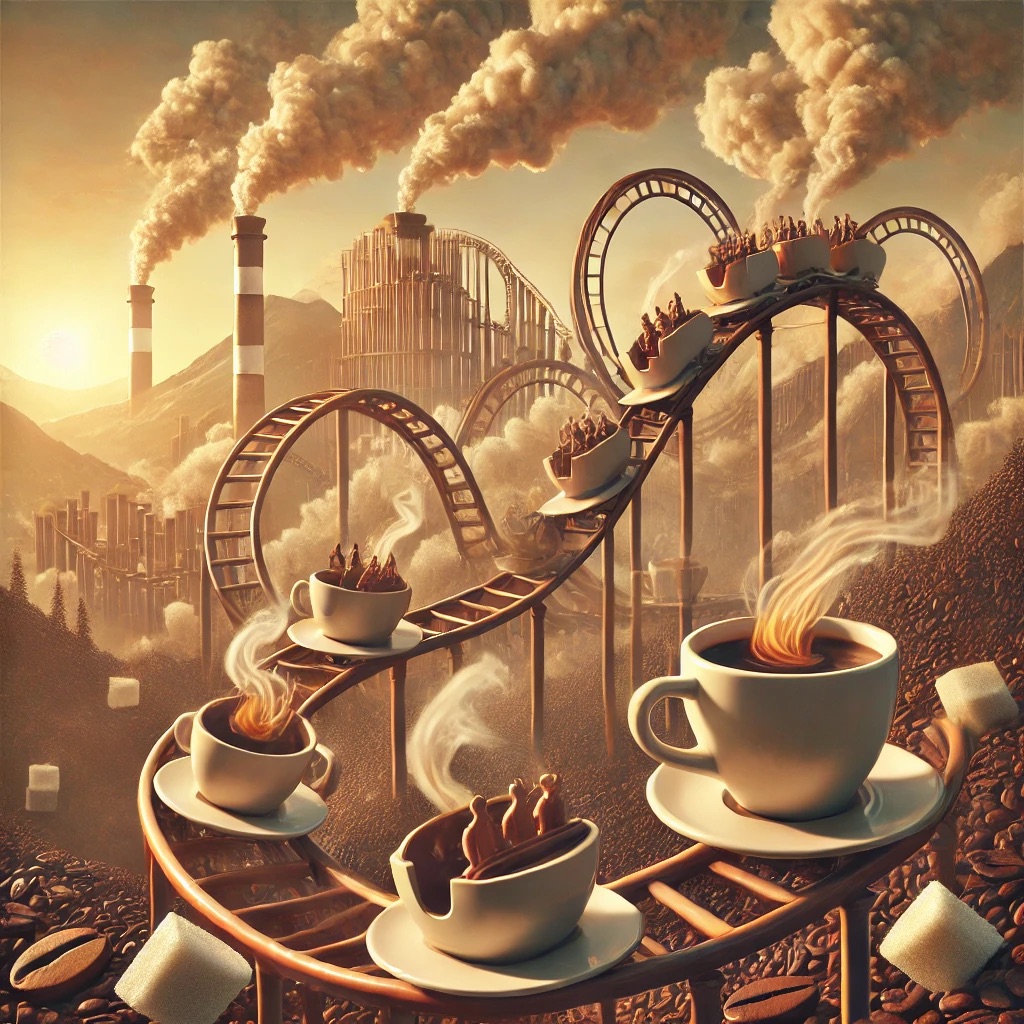If you have any connection to the outside world, it would be impossible to miss the fact that stuff is happening in the coffee world. Daily newspapers are laden with $12 per cup hysteria and it’s in the news and your social feed too. What’s going on?
Coffee is more expensive than it has ever been!
Green coffee prices are going crazy!

- January 2024: Approx $5 AUD per kg (green bean C price. Think of this as the stock market price for non-specialty coffee or the “base price” for commodity grade coffee)
- January 2025: Nearly $13 per kg
- Today (February 2025) Near $16/kg.
We don’t buy any “C” price commodity coffee at all and It’s normal for us to pay anywhere between $8 and $15 per kilo over that for our everyday beans. For the really special stuff, it can be way, way more. As an example, we have a coffee on offer at present which leaves us with little margin whatsoever when we sell it at $250/kg. For everyday coffee which we purchase, we’re now seeing price increases: As an example, our favourite Brazil used in some blends and also as one of our popular single origins has increased in price by 70% in the last 6 months.
Is this a good thing?
Yes and No: In a sense it’s a good thing. We all know that coffee growers frequently get the wrong end of the stick when it comes to living comfortably. There are many steps between the coffee cherry on a tree and the cup you like to drink. Place any number of mouths to feed along the way and there are inevitable multipliers in price.
One of the good things about the increase in C price, is that growers of commodity coffee are currently on a better deal than they might have been for quite some time.
In addition, climate change is hitting coffee production. We’re seeing it at home and even moreso at origin. Droughts and floods influence production. Changes in temperature also influence pest activity and can compromise crops. Less coffee = higher pricing for it.
Panic?
It’s a perfect storm moment. When COVID started to impact our lives, we saw panic at the supermarkets. Toilet paper anyone? This is happening at buyer/broker level. A broker for a big roaster might well have locked in sell pricing with a client for the whole of 2025 at a per kg price which will be no longer viable given the direction that future pricing is heading. They will try to stockpile to “hedge” against these fluctuations and maintain margins. Increased demand = increased prices due to lower global stores. Funny thing is like toilet paper, there actually is sufficient to go around, but people panic.
Roasting shrinks coffee
When you roast coffee, moisture is lost. It’s not unusual to “lose” 15% of coffee mass as moisture. The price in the bag increases.
Operating costs expand coffee
You’ve seen it at home: Your utility bills have increased. Power and gas have increased as has your mortgage. Our operating costs are similarly influenced. The cost of operating the man-cave is way, way up. Body corp. fees anyone? Up 60+ percent from 2022. Gas pricing in particular will continue to move north as suppliers maintain profits whilst squeezing supply.
Here are some of the other costs that go into delivering just 1kg of coffee to you:
- Packaging: $0.90 – $1.75 per coffee bag.
- Satchels: $0.50-0.75 for each order
- Operating costs: Wages, insurance, rent, electricity, and WorkCover plus the outlay on a roaster and infrastructure which cost well over $100k to purchase. To cover these costs means that the greens need to at minimum double in price by the time they’re with you to allow us to break even without any margin whatsoever- but that’s not sustainable. That TC bloke likes to be paid- at least for some of the labour which goes into your cup of coffee.
So, what does it all mean?
To this point, we have maintained pricing as much as possible by absorbing the increases, but it’s ultimately not sustainable. As new coffees arrive, pricing will need to increase. We could go the “shrinkflation route” and supply you with less at similar pricing, but we don’t support that. We could also just buy much cheaper commodity coffee and hope that you won’t notice. You will notice though. We won’t do that.
Some things are going to need to change though:
Complementary freight on bigger orders has been suspended for the time being. We will however continue to subsidise your freight on your coffee order. The more you buy, the more you effectively save. Perhaps purchase with a mate or you might even consider stocking up and freezing some? Freezing beans works brilliantly in barista competitions and it’s a very good thing. Just don’t freeze/thaw/freeze ad infinitum.
So, bean prices will increase. Quality will not be compromised:
We’re doing our utmost to remain competitive but at far higher quality than “the locals”. By running in a lean and mean manner, our blends can use beans of a quality that the biggies can’t afford. You can taste that and it’s something we won’t compromise on.
So, where to from here?
Many years ago, an industry icon shared some wise advice: “It takes just as long to make a good coffee as a bad coffee, so why not make a good coffee?” He also said: “I’d rather one great coffee than two bad coffees”. Smart fella, that bloke.
I feel that things will settle in time, but for the moment, I’m with my mentor. I’d much rather drink fewer great cups than compromise what’s in each cup. I hope you agree….
Chris